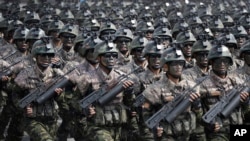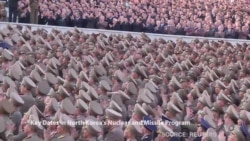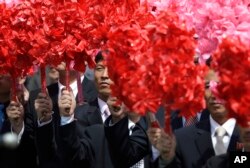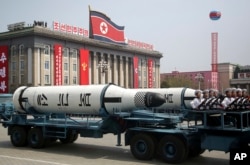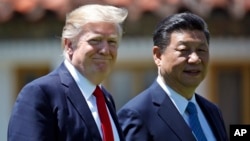North Korea did not go through with a possible nuclear test Saturday, after the United States demonstrated a credible threat of military force in the region and China increased economic restrictions against its economically dependent ally, but Pyongyang did later conduct a missile test that failed.
The missile was launched early Sunday from the Sinpo area on the North's east coast, where the country has a submarine base. The U.S. Pacific Command said the missile blew up almost immediately and that its type was still being assessed.
Earlier, North Korean leader Kim Jong Un presided over a military parade to celebrate the April 15 birthday of his country's founding leader the late Kim Il Sung, the country’s most important holiday known as the Day of the Sun.
“Kim Jong Un had planned a fight with the U.S., but decided to give up the plan,” said North Korea defector and analyst Ahn Chan-il with the World Institute for North Korean Studies.
Watch: Key Dates in North Korea's Nuclear and Missile Program
Military pressure
Expectations of an imminent North Korean nuclear test grew this week based on reports of recent activity at the Punggye-ri nuclear test site and Pyongyang’s pattern of conducting provocative military tests to coincide with the birthday of the nation’s founding leader.
Since January 2016, Pyongyang has acted with little restraint, conducting two nuclear tests and attempting numerous medium- and long-range ballistic missile launches. This year Kim Jong Un indicated that his nation is in the final testing phase of an intercontinental ballistic missile (ICBM) that could potentially hit the U.S. mainland.
U.S. President Donald Trump, however, has placed a high priority on preventing North Korea from developing a credible long-range nuclear ballistic missile capability that could directly threaten U.S. national security.
The U.S. Pacific Command this week sent the USS Carl Vinson nuclear-powered aircraft carrier naval formation that includes guided missile destroyers and aircraft squadrons to the region.
And last week’s U.S. airstrikes against Syria for using chemical weapons added credibility to statements made by the Trump administration that it is prepared to take military action against North Korea as well. Following the Syrian strike, North Korea’s KCNA news agency said the Trump administration, “has entered the path of open threat and blackmail.”
A temporary pause
While Pyongyang seems to have backed down to U.S. military pressure for now, it is likely only a temporary pause.
The North’s military parade Saturday prominently displayed submarine-launched ballistic missiles (SLBM) for the first time, demonstrating its own increasingly advanced and diverse military capabilities.
Choe Ryong Hae, a close aide to Kim, addressed the packed square and reiterated the warning to the United States.
“If the United States wages reckless provocation against us, our revolutionary power will instantly counter with annihilating strike, and we will respond to full-out war with full-out war and to nuclear war with our style of nuclear strike warfare,” he said.
North Korean state media earlier warned the United States to end its “military hysteria” or, “Our toughest counteraction against the U.S. and its vassal forces will be taken in such a merciless manner as not to allow the aggressors to survive.”
Economic pressure
Trump has also been pressing China to do more to rein in North Korea, and has held out the offer of better trade terms for halting Pyongyang’s nuclear program.
Trump this week praised Chinese President Xi Jinping after Beijing sent back a fleet of North Korean ships carrying coal in accordance with United Nations sanctions. In February China banned all imports of North Korean coal, which is a lucrative source of income for the country. North Korea relies on China for 90 percent of its trade.
On Friday, China’s national airline, Air China, also canceled some flights to the North Korean capital, Pyongyang, citing poor demand.
Trump and Xi discussed the North Korean nuclear threat during a recent summit at the U.S. president’s Mar-a-Lago retreat in Florida. They spoke again over the phone Thursday. Afterward Trump said he believed Xi would “work very hard” to help resolve the tense situation on the Korean Peninsula.
Chinese Foreign Minister Wang Yi Friday urged all parties to “refrain from provoking and threatening each other, whether in words or actions, and not let the situation get to an irreversible and unmanageable stage.”
While China opposes the North’s nuclear program it is reluctant to take harsh measures that would cause instability at its border and that would increase U.S. power in the region.
Youmi Kim contributed to this report.




